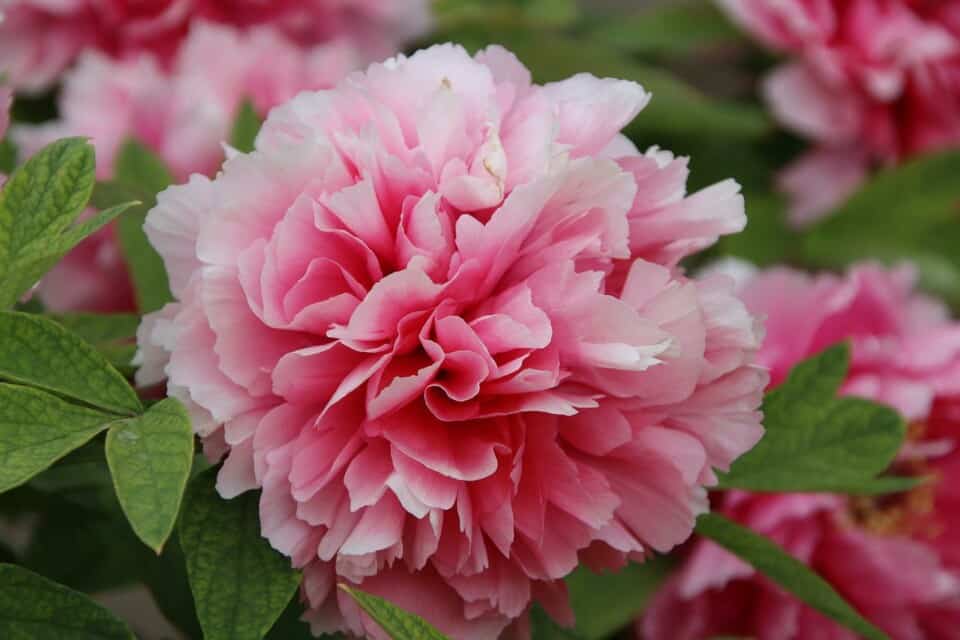Some links in the post are affiliate links and I get a commission from purchases made through some links found in the post.
The sight of peony flowers is worth the number of years you must put into their care before these plants bloom. And I was eagerly awaiting the day I would finally enjoy this experience.
I longed to hold these flowers, take in their scent, and take enough pictures to last a lifetime. The first few days after my peonies bloomed, I was over the moon.
No sooner had I started basking in their beauty than something horrible happened – they started drooping. I was frantic, wondering what I could have done wrong at such a vital time.
It turned out that the blooms were too heavy for the stems to bear – not because the plant was weak but because that’s something that happens to peonies.
So, if your peony has suddenly started drooping then it could be the weight of the flowers.
If it is not the weight of the flower, your peony could be drooping due to underwatering, a poor soil mix, high temperatures and pests.
Which I will show you how to combat. Are you ready? Let’s change that droop into a fantastic backdrop for your garden, shall we?
Why Is Your Peony Drooping?
I like to think of drooping as a plant expressing its sadness. It’s like when humans feel sad – we slump our shoulders, wear forlorn looks on our faces, and have reduced energy to go about our lives.
When plants droop, they are unhappy. But what’s making your peony unhappy?
1) It Has Too Much Weight to Bear
 Peonies have striking blooms that catch people’s eyes from afar. But the color of the blooms is not the only reason we can enjoy these flowers from far.
Peonies have striking blooms that catch people’s eyes from afar. But the color of the blooms is not the only reason we can enjoy these flowers from far.
Their sizes also contribute a lot to this visibility. Peony flowers are massive and quite hefty.
So, once the buds start opening and the flowers start taking on the spaces, it’s easy for the stems to feel the weight of the flowers. And sometimes, the stems cannot withstand this weight and fall over.
Usually, the falling over takes a few days after the buds have opened. However, it can be sooner if:
- You live in a windy region, and the winds put pressure on the stems, which give in and fall to the ground, or
- It rains, and the plant now must withstand the weight of the rain and the flowers. Usually, the plant flops to the ground.
If you leave the peony on the ground, its flowers will not get to bloom fully. Besides, you end up missing out on the aesthetic of the flowers because you cannot enjoy them when they are flat on the earth.
How to Deal with Falling/ Drooping Peonies
The stems on most perennial peonies cannot withstand the weight of their blooms. So, the best way to protect them is to offer them additional support. Your options include:
- Cages: How about housing your plant? This option often works for smaller plants as you will not need a lot of material to surround the plant. Even so, you should note that as the plant grows bigger, you will need to increase the size of the cage.
- Grids: These supports are essential in protecting the peony from toppling over. They surround the plant and are more flexible than cages, allowing it to enjoy a wide berth when growing.
When getting any support for your plant, you must consider the size of your plant. The support must be in line with the height and width of the peony.
For example, if your plant is tall, the peony must be as tall or even taller than it. Else, when the plant starts falling over, there will be nothing on its side to keep it from doing so.
Getting a support that is shorter than the plant thus will not have the desired effect. Also, consider the width of the plant. You want to use a support that surrounds the plant.
It should allow it enough room to grow outwards but should not leave a space where the falling peony can occupy and fall flat on the ground.
You may also like: Do peonies bloom more than once
Timing
At what point should you add support to your peonies? In my case, I had to act fast and without much preparation as I was dealing with a crisis.
I would have preferred to be more methodical, but that was not an option. But now that I successfully evaded that issue, here are my best timings for peony supports:
The Spring
Spring is an ideal time to add support. After all, your peony will be in active growth, and you can use the support to guide its growth.
Note that when installing supports in the spring, you should consider that the plant will grow much taller by the time it blooms.
So, create supports that can handle this imminent growth. The downside to adding supports in the spring is that they can damage the new growth.
However, thanks to the active growth, the plant will heal and move in line with the supports.
The Fall
You can also wait until the fall when you have already pruned your peony. This timing allows the plant to overwinter in the supports as it enjoys chilling hours.
As the buds form and the plant gets heavier, it will lean on the supports such that by the time it blooms, it will have evenly distributed its weight across the system.
Note that this is only an option if your plant has already bloomed. Else, you should support it in spring to prevent it from falling over.
Adding support for your plant once it has bloomed is not the best idea. Peonies are quite weak, and too much handling can cause them to break off, forcing them to use their energy on healing rather than blooming.
Execution

How should you install the supports around the peony? There are two things to consider:
- Peonies have weak new growths that can fall off if mishandled: You will want to ensure that you do not damage the plant’s foliage or stems, as this would be a setback.
- Peonies have shallow root systems, and as you dig into the earth, you could damage them. Once this happens, the plant would have no choice but to focus more on root reparation to enable it to absorb nutrients.
As such, you should ensure that the support is wider than the extent of the peony’s root ball.
Drive the supports into the ground, and in the months that follow, train the peonies around or inside the support.
You can always add more support if you notice any flowers falling over, even with the support in place. There is no harm in taking extra precautions.
You may also like: What are the common peony problems
2) It Does Not Have Enough Water
What if your plant is not falling over completely but instead leaning over? And even with support, it still seems lifeless. What could be the issue?
In most instances, this comes down to underwatering – this is an imbalance between the water the plant absorbs and what it loses to the environment. But what causes this?
Neglect
When we grow plants outdoors, it’s natural to forget that they need supplemental water at times. We sometimes leave the watering to the rain.
And when it does not fall, our plants suffer. It could be that your watering schedule is not optimal for the peony.
As such, it would use the water available for photosynthesis and would soon run out of water to maintain its cellular activities.
Dealing with Neglect
As much as your plant grows in the outdoors, rain might not be sufficient to sustain its healthy growth. Peonies have shallow roots that cannot access water in lower water tables.
They quickly dehydrate if they go for long periods without water. They prefer being in moist soil (not damp). And you can achieve this by ensuring they get at least an inch of water per week.
Please note that this also includes rainwater. Else, if you give the plant too much water, overwatering ensues, and the plant can die due to root rot. Here’s how to water your peony:
1) Check the top two inches of soil by digging your finger into the earth
Your peony needs water if the soil feels dry. But if it feels moist, give it a few days, then check again. Sometimes, gauging the difference between dry and moist soil can be challenging.
You can always invest in a moisture meter to help you know when to get the jerry can and when to walk away.
2) If the soil feels dry, you need to water it deeply
When doing so, aim at the base of the plant and not its leaves. Peonies are highly susceptible to fungal diseases. Thus, watering its leaves will only put it at risk of fungal attacks.
Add a layer of organic mulch around the base of the plant. It helps the plant maintain moisture for longer. Plus, as it breaks down, it also feeds the plant.
3) A Poor Soil Mix
Does your peony have the type of soil it needs? Peonies must always be in well-draining soil that allows the excess water to drain but retains just enough to support the plant’s growth.
If the plant is in soil that drains most of the water, the roots can end up dehydrated.
What’s the Right Peony Soil Mix?
Peonies prefer well-draining and moist soil. Typically, any soil mix for an azalea will also work for a peony.
You should choose a soil mix that is well-draining and well-aerated, which you can get in most loamy soils.
If your current soil mix drains too much water, you can amend it with some compost, as compost has a high water retention rate.
Take note that too much water retention can harm the plant. So, only use a small amount of compost at a time.
You may also like: 8 reasons your peony plant is turning brown
4) High Temperatures
In the summer, the temperatures can get unbearably hot, resulting in drooping.
Handling High Temperatures
If your plant is outdoors in the sweltering heat, the best action is to water it to keep up with water loss. I will get into this when curating a watering schedule for your peony.
You can also mulch the plant around its base. Not only does this help it retain water, but it also reduces the chances of weeds growing around it.
Another option lies in adding shade plants around the peony. However, you should be cautious about this as too much shade can reduce the light exposure time, resulting in other issues.
For indoor plants, all you need to do is move the plant to a cooler spot in the home. You should also look into whether the plant gets enough water as you must balance the water loss and water absorption rates.
Do you resonate with any of the above issues? Please follow the suggested solutions and nurse your peony back to good health.
You may also like: 6 reasons why your peony is curling & how to fix them
5) It’s Infested by Pests
 If you can rule out underwatering and weight issues, it’s time to consider that pests may be affecting your peony.
If you can rule out underwatering and weight issues, it’s time to consider that pests may be affecting your peony.
Pests suck on the plant juices, weakening it and exposing it to disease-causing microorganisms. Some of the pests you should watch out for include:
- Scales,
- Mites,
- Thrips
Inspect the plant for signs of pest attacks by checking the undersides of the leaves with a magnifying glass. Also, look for spots on the plants or signs of yellowing and curling.
What to Do About Pests
You must deal with pest infestations as soon as you confirm their existence. Do so by applying insecticidal soap or pesticides on the affected plant and cutting off the affected parts.
While this measure will rob you of full bloom, it will ensure you get a full one in the coming season. Once the infestation clears, start using neem oil on the plant to prevent another attack.
Final Thoughts
Is it too late for your drooping peony? You must always move with haste once you notice your peony falling over or drooping.
If watering is the issue, fix it before the plant dehydrates and stops supporting its flowers. And if weight is the issue, find support before the plant falls over.
It’s only too late when the plant falls flat on the ground because that damages its stems and hampers its ability to sustain its blooms. But until that happens, you can save your plant from such an untimely end.
Happy Gardening!

